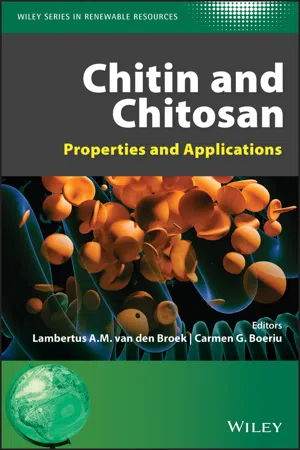
Chitin and Chitosan
Properties and Applications
- English
- ePUB (mobile friendly)
- Available on iOS & Android
Chitin and Chitosan
Properties and Applications
About This Book
Offers a comprehensive guide to the isolation, properties and applications of chitin and chitosan
Chitin and Chitosan: Properties and Applications presents a comprehensive review of the isolation, properties and applications of chitin and chitosan. These promising biomaterials have the potential to be broadly applied and there is a growing market for these biopolymers in areas such as medical and pharmaceutical, packaging, agricultural, textile, cosmetics, nanoparticles and more.
The authors – noted experts in the field – explore the isolation, characterization and the physical and chemical properties of chitin and chitosan. They also examine their properties such as hydrogels, immunomodulation and biotechnology, antimicrobial activity and chemical enzymatic modifications. The book offers an analysis of the myriad medical and pharmaceutical applications as well as a review of applications in other areas. In addition, the authors discuss regulations, markets and perspectives for the use of chitin and chitosan. This important book:
- Offers a thorough review of the isolation, properties and applications of chitin and chitosan.
- Contains information on the wide-ranging applications and growing market demand for chitin and chitosan
- Includes a discussion of current regulations and the outlook for the future
Written for Researchers in academia and industry who are working in the fields of chitin and chitosan, Chitin and Chitosan: Properties and Applications offers a review of these promising biomaterials that have great potential due to their material properties and biological functionalities.
Frequently asked questions
1
Sources of Chitin and Chitosan and their Isolation
1.1 Chitin and Chitosan
1.1.1 Chemical Structure
Table of contents
- Cover
- Table of Contents
- List of Contributors
- Series Preface
- Preface
- 1 Sources of Chitin and Chitosan and their Isolation
- 2 Methods of Isolating Chitin from Sponges (Porifera)
- 3 Physicochemical Properties of Chitosan and its Degradation Products
- 4 New Developments in the Analysis of Partially Acetylated Chitosan Polymers and Oligomers*
- 5 Chitosan‐Based Hydrogels
- 6 Beneficial Health Effects of Chitin and Chitosan
- 7 Antimicrobial Properties of Chitin and Chitosan
- 8 Enzymes for Modification of Chitin and Chitosan
- 9 Chitin and Chitosan as Sources of Bio‐Based Building Blocks and Chemicals
- 10 Chemical and Enzymatic Modification of Chitosan to Produce New Functional Materials with Improved Properties
- 11 Chitosan‐Based DrugDelivery Systems
- 12 The Application of Chitin and its Derivatives for the Design of Advanced Medical Devices
- 13 Food Applications of Chitosan and its Derivatives
- 14 Potential of Chitosans in the Development of Edible Food Packaging
- 15 The Use of Chitosan‐Based Nanoformulations for Controlling Fungi During Storage of Horticultural Commodities
- 16 Chitosan Application in Textile Processing and Fabric Coating
- 17 Chitin and Chitosan for Water Purification
- 18 Chitosan for Sensors and Electrochemical Applications
- 19 Marketing and Regulations of Chitin and Chitosan from Insects
- Index
- End User License Agreement